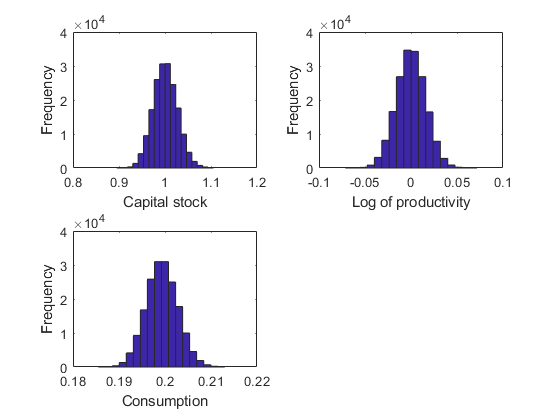GRO1 Stochastic growth model
Contents
Model's structure
Response variable Consumption ( ).
).
State variable Capital stock ( ), Log of productivity (
), Log of productivity ( ).
).
Shock Innovation to productivity ( ).
).
Parameters Capital depreciation rate ( ), Discount factor (
), Discount factor ( ), Elasticity of intertemporal substitution (
), Elasticity of intertemporal substitution ( ), Capital share (
), Capital share ( ), Scale parameter (
), Scale parameter ( ).
).
Equilibrium equation
![$$C_{t}: C_{t}^{-\tau}=\beta\mathrm{E}_{t}\left[C_{t+1}^{-\tau}\left(1-\delta+a \alpha e^{Z_{t+1}}K_{t+1}^{\alpha-1}\right)\right].$$](gro1_eq17171729093805930249.png)
Transition equations


Writing the model
The model is defined in a Yaml file: gro1.yaml.
Create the model object
Mean and standard deviation of the shocks
Mu = 0; sigma = 0.007;
You generate the MATLAB model file and pack the model object with the following command
model = recsmodel('gro1.yaml',... struct('Mu',Mu,'Sigma',sigma^2,'order',5));
Deterministic steady state (different from first guess, max(|delta|)=1.75094e-08)
State variables:
K Z
_ _________
1 3.216e-22
Response variables:
C
_______
0.19928
Expectations variables:
E
______
26.505
This command creates a MATLAB file, gro1model.m, containing the definition the model and all its Jacobians from the human readable file gro1.yaml.
Define approximation space using Chebyshev polynomials
Degree of approximation
order = [10 10];
Limits of the state space
smin = [0.85*model.sss(1) min(model.shocks.e)*4]; smax = [1.15*model.sss(1) max(model.shocks.e)*4];
[interp,s] = recsinterpinit(order,smin,smax,'cheb');
Find a first guess through first-order approximation around the steady state
[interp,x] = recsFirstGuess(interp,model,s,model.sss,model.xss);
Define options
With high order Chebyshev polynomials, extrapolation outside the state space should not be allowed to prevent explosive values.
options = struct('reesolver','krylov',... 'extrapolate',0 ,... 'accuracy' ,1);
Solve for rational expectations
interp = recsSolveREE(interp,model,s,x,options);
Newton-Krylov solver
Major Residual Minor 1 Relative res. Minor 2
0 1.32E-04 0 1.00E+00 0 (Input point)
1 2.70E-05 1 2.04E-01 0
2 1.88E-05 1 6.97E-01 0
3 2.80E-06 2 1.49E-01 0
4 4.97E-08 3 1.78E-02 0
5 1.12E-09 4 2.26E-02 0
Simulate the model
[~,~,~,stat] = recsSimul(model,interp,model.sss(ones(1000,1),:),200,[],options); subplot(2,2,1) xlabel('Capital stock') ylabel('Frequency') subplot(2,2,2) xlabel('Log of productivity') ylabel('Frequency') subplot(2,2,3) xlabel('Consumption') ylabel('Frequency')
Statistics from simulated variables (excluding the first 20 observations):
Moments
Mean StdDev Skewness Kurtosis Min Max pLB pUB
___________ _________ _________ ________ _________ ________ ___ ___
K 1.0007 0.026494 0.11057 3.0062 0.89474 1.1053 NaN NaN
Z -3.3217e-05 0.015946 0.0022828 2.9987 -0.071637 0.071787 NaN NaN
C 0.19934 0.0034279 0.078804 2.989 0.18546 0.21301 0 0
Correlation
K Z C
_______ _______ _______
K 1 0.52294 0.94816
Z 0.52294 1 0.76667
C 0.94816 0.76667 1
Autocorrelation
T1 T2 T3 T4 T5
_______ _______ _______ _______ _______
K 0.99396 0.98004 0.95955 0.93366 0.90339
Z 0.8772 0.7681 0.67239 0.58658 0.51118
C 0.9733 0.94265 0.90909 0.87289 0.83506
Accuracy of the solution
Equilibrium equation error (in log10 units)
Max Mean
-2.9649 -4.9531
